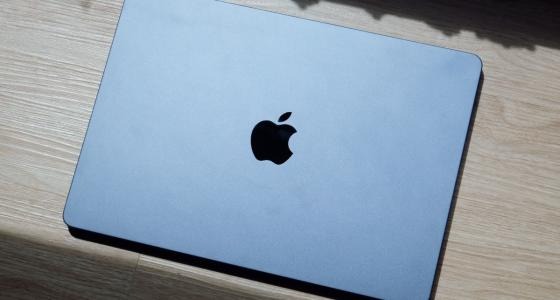Review of the Apple MacBook Pro M3: Iconic laptop returns in black
4 min read
Contents
Enhanced laptop features M3 chips, increased power, extended battery life, vivid display, reduced cost, and a darker hue.
The upgraded MacBook Pro from Apple introduces a broader range of chip options, a more affordable price, and a new black color choice, all while delivering enhanced performance and extended battery life.
Priced at £1,699 (€1,999/$1,599/A$2,699), the beloved laptop is now more accessible, being £450 cheaper than its predecessor, significantly lowering the entry barrier.
Retaining the attractive blend of retro and modern design in its aluminum build, the machine maintains the precision befitting its cost. The port selection remains unchanged, featuring the welcomed HDMI port and full-size SD card slot.
The laptop’s display continues to stand out as one of the best, boasting sharpness, smoothness, and impressive brightness, particularly when handling HDR content. In general use, the screen is now 20% brighter compared to its predecessor, a noticeable improvement, especially when working on documents in bright winter sunlight.

For 2023, a fresh addition is the space black color choice, leaning towards a deep shade of grey but achieving the darkest tone possible for anodized aluminum. Its aesthetic appeal is impressive, and it effectively resists fingerprints better than its predecessor. This new color option is exclusive to the mid- and high-end configurations of the machine, with prices starting at £2,099 (€2,499/$1,999/A$3,499).
Technical details
- Display: 14.2-inch mini LED (3024×1964; 254 ppi) with ProMotion (120Hz)
- Processor: Apple M3, Pro, or Max
- RAM: Options of 8GB, 18GB, 32GB, or up to 128GB
- Storage: SSD options ranging from 512GB, 1TB, 2TB, 4TB, to 8TB
- Operating System: macOS 14.1 Sonoma
- Camera: 1080p FaceTime HD camera
- Connectivity: Wifi 6E, Bluetooth 5.3, 2/3x USB/Thunderbolt, HDMI 2.1, SD card slot, headphone jack
- Dimensions: 221.2 x 312.6 x 15.5mm
- Weight: Ranges from 1.55 to 1.62kg.
Selection of M3, M3 Pro, and M3 Max chips.
A noteworthy development is the introduction of Apple’s latest M3 chip family, produced on a cutting-edge scale currently unparalleled by other manufacturers. This advancement enhances performance, reduces power consumption, and minimizes heat generation.
The entry-level 14-inch MacBook Pro now features the M3 chip, with options to upgrade to the M3 Pro and M3 Max for more demanding performance requirements.
Compared to the M2 chip in the MacBook Air and other devices, the M3 chip boasts approximately 20% higher speed, and it is about 40% faster than the original M1 chips from 2020. The base model supports a single external monitor and comes with 8GB of memory, which is likely sufficient for current needs but could pose limitations in the future. Doubling the memory incurs a £200 cost and cannot be retroactively upgraded.
For users requiring additional power, more ports, and the ability to connect multiple external monitors, the M3 Pro chip is an ideal choice. It excels at handling demanding tasks and is likely the best fit for those utilizing the MacBook Pro for professional work. At the top tier is the M3 Max chip, delivering a remarkable level of performance in a laptop. While it may be overkill for most users, it is a valuable option for those seeking workstation-level power and are willing to make a substantial investment.
Sustainability
Comprising 32% recycled materials such as aluminum, rare earth elements, tin, gold, and plastic, the MacBook Pro reflects Apple’s commitment to sustainability, as detailed in its environmental impact report.

The laptop is designed for general repairability, accompanied by available repair manuals. Apple facilitates battery replacement at a cost of £245. While the modular design earned praise from repair specialists iFixit, criticism arose for Apple’s use of software locks on replacement parts, limiting third-party repair options and resulting in a repairability score of only four out of 10. Apple extends its commitment to the environment through trade-in and free recycling programs, inclusive of non-Apple products.
Price
The 14-inch MacBook Pro has an initial price of £1,699 (€1,999/$1,599/A$2,699) for the M3 chip with 8GB of RAM and 512GB of storage. Models featuring the M3 Pro are priced starting at £2,099, while the M3 Max variants begin at £3,299.
For comparison, the MacBook Air M2 is priced at £1,149. In the realm of Windows laptops comparable to the new MacBook Pro models, such as the Dell XPS 15, the cost is around £2,000. The Razer Blade 14 is priced at £2,499, and Microsoft’s Surface Laptop Studio 2 starts from £2,069.
Conclusion
This year, Apple’s longstanding Pro laptop offers more options than ever. While the lower starting price of £1,699 is a welcome change, it remains relatively high, and the inclusion of a chip, though exceptionally fast, may not meet the demands of professional work, coupled with the limitation of only 8GB of memory.
This makes it challenging to recommend the base model over the outstanding MacBook Air for Apple users. However, the M3 Pro and Max models stand out as an impressive blend of power and efficiency, surpassing offerings from other manufacturers. In this aspect, Apple continues to demonstrate significant strength.
The 14-inch size maintains its status as the sweet spot in laptops, enhanced by a striking screen, best-in-class trackpad and keyboard, and a robust selection of ports. While it comes at a price, if Windows 11 is not a specific requirement, it stands out as one of the finest working laptops available. Additionally, the new black color adds to its aesthetic appeal.
Pros:
Varied chip options, extended battery life, an outstanding miniLED ProMotion screen now even brighter, ample ports and an SD card slot, impressive speakers, Touch ID functionality, excellent keyboard and trackpad, the 14-inch size is ideal, and the new black color is a notable addition.
Cons:
Absence of USB-A, Face ID not included, lacks a Centre Stage camera, inability to upgrade RAM or SSD post-purchase, relatively high cost, and the base model compromises on memory given its price.





